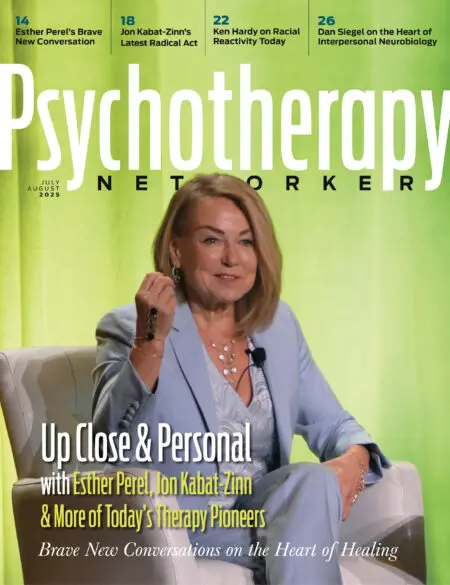Enjoy the audio version of this article—perfect for listening on the go.
What’s the secret to therapeutic change? f you asked a dozen therapists this question, you’d probably hear a dozen different answers, many long and complex.
But if you asked Brigham Young University professor Ben Ogles—a leading psychotherapy outcome researcher, who’s spent more than 25 years studying the common denominators in personal growth and change—he’ll tell you the answer really isn’t so complicated after all. In fact, Ogles has boiled it down five factors—and you’ll find them in almost every therapeutic modality!
What does this mean for therapists who are laser-focused on learning a particular approach, convinced it’s the most effective? Or for clients who feel they need a particular kind of therapy to heal? Is reducing change and growth to a few key principles the best way to inform the way we work? Will it really keep us focused on what’s most important?
In Ogles’s book Common Factors Therapy: A Principle-Based Treatment Framework, he and his coauthor, psychologist and professor Russell Bailey, make a compelling argument, outlining a new modality that pulls from approaches across the board and grounds us in the basic building blocks of change.
Here he gives us an overview of common factors research and, perhaps, a hint about the future of integration in our field.
Ryan Howes: What first inspired the research into common factors and how did it unfold?
Ben Ogles: Back in 1936, American psychologist and therapist Saul Rosenzweig first speculated that what the theorists suggested creates change may not actually be the things creating change. So what does create change? For decades, researchers have done horse-race studies comparing different theoretical orientations for treatment, and they repeatedly found that various treatments are mostly the same in terms of effectiveness. Some things work better in some instances, like exposure therapy for obsessive compulsive disorder, but if you just take the general anxious-depressed person, anything works.
That finding sparked researchers like Mike Lambert to find the things that lead to change that are common across treatments. In reviewing the literature, he showed the things that can consistently predict change regardless of the orientation, and he divided them into support factors, learning factors, and action factors. Other researchers did similar sorts of things.
In another sphere, Marv Goldfried, partly because he wanted to seek some unity among different orientations, surveyed clinicians to find the common principles of change outside of theory and technique. In his surveys, he consistently found that there were five principles of change that therapists could agree on.
So on the one hand you have researchers asking, “Does this variable predict change regardless of the orientation?” And on the other hand you have researchers asking, “Do therapists agree on this principle of change regardless of their orientation?” But Scott Miller, Barry Duncan, and Mark Hubble referred to these two problems as the Tower of Babel Problem—just using different language for the same thing. And so that’s where Russ Bailey and I got interested in common factors.
One day we were having a conversation with Mike Lambert, and we started to wonder, “Okay, so these common factors predict change. Can you make a therapy that’s a common factors version of therapy?” Russ thought so. He said, “You can make a therapy that’s called Common Factors.” Mike said, “No, that’s not possible. That’s just a name for principles that predict change. It’s not a theory of change. In fact, it’s kind of a meta theory, So in order to make it a therapy that you use, you’re going to have to make it more practical and pragmatic. You’re going to have to have a theory of change. You’re going to have to have techniques.”
Russ thought it was possible, and I hesitantly jumped on board. We worked hard on an article focused on one principle of change, the therapeutic relationship. And then he said he thought we could do this in a book format. So we submitted something to APA and they liked it. We came up with five principles in the end, and that’s how we published the book on a common factors framework for delivering treatment.
RH: What are the five principles of effective therapy?
Ogles: They are the therapeutic relationship, motivation, corrective experiencing, insight, and self-efficacy. They really match up with what Marv Goldfried originally came up with in 1980. We don’t use exactly the same words, but in each chapter, we try to present the evidence and research that this principle of change does predict outcome, and then we try to show how it fits into a variety of orientations using different language.
No one ever has any quibbles with the first of the principles, which is the therapeutic relationship. Second is client motivation, and a lot of the interventions there, as you might expect, have to do with motivational interviewing and expectancies, helping people to have the expectation of change. We see those two as the foundation of the house of change, if you will.
Then comes a cognitive avenue with insight, and an emotional avenue with corrective experiencing. And those aren’t completely distinct. It’s not like you have insight without any emotion, or corrective experiencing without any insight.
We call the top of the house self-efficacy, which is more of the behavioral, practical change that comes as people think differently.
RH: I was taught that corrective emotional experience was a psychoanalytic construct proposed by Franz Alexander and Thomas French.
Ogles: Sure, the Alexander and French stuff would fit within the corrective experiencing part of our framework. But we’d also put exposure as a corrective emotional experience, because in a sense, the person is confronting their past view.
Similarly, we’d put things like cognitive reframing, psychoanalytic interpretation, and humanistic reflection under insight, because the person is discovering something about themselves, whether through hearing something they said in a slightly different way or having a question posed to them they’d never thought of before. We’d even put straight psychoeducation there. So if you gave them homework to read, that would also be the kind of learning that we call insight.
In essence, we’re offering a collection of things from different orientations under a principle framework, and it can inform the way that someone thinks about their therapy.
RH: The first principle is the relationship, and everyone agrees on that. But what is it about the relationship that’s such a healing or essential component?
Ogles: When you start to dig into the research literature, you find it’s about having a shared, trusting bond, a shared set of goals, and a shared set of tasks. And this matches up with one of the major players in the common factors world, Jerome Frank, who co- wrote Persuasion and Healing. He talks about four things that are common to all therapies and healing rituals. One is a healing setting, whether it’s a sweat lodge or a confessional for a priest or a therapist’s room with the diplomas on the wall. The next is what he calls “an emotionally charged confiding relationship.” And then the other two are a theory of change and some ritual that you must pass through, whether it’s sitting in the sweat lodge or analyzing your thoughts through a three-column technique or whatever the ritual is that’s tied to that theory of change.
RH: A safe bond and a trusted process for change.
Ogles: But part of it is that you have to agree on this theory and this ritual, the goals and the task. It has to be culturally acceptable in that way. If it gets too far outside the culture, the client won’t believe it, and it’s not going to work.
RH: So you have the relationship, the motivation, the cognitive strand, the emotional strand, and then the behavioral roof, as you put it, which is self-efficacy. Is that a need to prove these changes are lasting and show that I’ve made some change in my life?
Ogles: Yeah, but it’s not so much about evidence as it is about practice.
For example, in my therapeutic training, I became aware that I’m somewhat possessive of things, a result of growing up in a home where I was the oldest of nine children. This sense of possessiveness really came out when I got married. I realized that some of the things she did that bothered me came from being 10 years old and having a bunch of little kids messing with your stuff all the time.
But just because I’m aware of that when I’m 35 and married doesn’t mean that I’ll change how I respond to situations where that possessiveness kicks in. Just because you have the corrective experience or the insight doesn’t mean it necessarily translates into your behavior after you’re aware. That’s where the self-efficacy needs to kick in.
RH: Does a common factors approach assist with integration of modalities or does it make the whole concept irrelevant, because why have all these modalities if we only need effective common factors?
Ogles: It’s a good question. It does add yet another approach to the mix. You have behavioral, humanistic, psychodynamic, cognitive, integrative, common factors. So, from one perspective, it didn’t help solve any problems; it created a new one. But from another perspective, it offers a more unified, integrative way of both viewing and treating people. And the trans-theoretical approach is gaining some ground, especially for treatment of depression and anxiety.
I’d add that our common factors approach isn’t a closed book. If another principle is identified that meets our criteria for cutting across other orientations and has research evidence for its predictive ability or change, then let’s add it. In that way, we have a hope that common factors isn’t something we possess. Rather, it’s a set of principles that therapists can use as a framework for how to think about change, even though their interventions may come from different conceptualizations.
RH: And those interventions might borrow from these preexisting modalities? If you’re going to talk about irrational thoughts and beliefs, for example, that’s already an established intervention.
Ogles: Yeah, the only difference with common factors is the way the therapist thinks about it in their head. Instead of using the cut-and-dry theoretical language about why it’s effective, they’re thinking about it in terms of insight as a common factor of change—and they’re using that intervention for that purpose.
So it might be that you see an irrational thought reframe and say, “There’s a cognitive therapist.” You wouldn’t know they were common factors therapists until they suddenly threw in a psychodynamic intervention. It would look exactly like a psychodynamic intervention, but they’d be thinking about it from a corrective experiencing lens.
RH: If I was in a graduate program and learning common factors therapy as a modality, then would I be learning to borrow from different modalities to apply the cognitive, emotional, and behavioral elements of common factors?
Ogles: Yeah, and in some ways it’s harder. I mean, if you look at Norcross’s work on psychotherapy integration and integrated psychotherapy supervision, he says that it’s harder because the supervisor has to be acquainted with more orientations and how they’re applied. So at least in our training program, if you visit with first year therapists, they gravitate toward a cognitive model because it’s so cut and dried and simple to implement. Then as they get more experienced and less anxious, they tend to spread out a little bit. So I don’t know if the common factors approach is the first place people would start, because you have to be acquainted with more orientations in order to really implement it.
RH: In my graduate program, we learned Carl Rogers’s client-centered therapy first, because it’s a strong framework for establishing the relationship.
Ogles: And it reminds me of Bill Miller’s work on motivational interviewing. He’s busy doing behavior therapy for alcohol use disorders and discovers that the therapists who have the best alliance are more effective than the ones who don’t. And so the birth of motivational interviewing comes out of this finding that the relationship matters a lot. It’s not just the technique of the behavior therapist. You have to start with a good relationship.
RH: I love the idea of having something that unifies or at least gives therapists a common language and goals. Can you talk about it from the client perspective, though?
Ogles: Almost all the work done on common factors is survey research of therapists and experts, research about what variables across orientations predict outcome, or theoretical things like how is this idea in this orientation similar to this idea and this orientation? Well, the thing that’s missing from that is the client’s view. What do clients think creates change?
We’re working on an article now based on a survey of 200 college students at a counseling center. We asked them, “What contributed to your change?” We identified 56 possibilities, based on the literature, and had the students rate how much they contributed to their change. And then we factor-analyzed that. When they aren’t primed, there’s clearly a therapist component to it. They’ll say, “My therapist was amazing.” “My therapist understood and supported me.” “My therapist listened.”
But sometimes there’s an expertise factor. They’ll say, “The therapist knew what I needed.” “The therapist was really good at helping me.” “The therapist knew how to work with me.” In a category we called client work, there were two things. One was the effort or motivation. “I put in the effort.” “The reason I made a change was because I desired to make a change.” And then there was something we call expression, which has to do with the therapist’s role and their own role as well. “I was willing to be vulnerable.” “They helped me to talk about my problems.”
And then there was one category we called skills or tools. “I learned how to deal with X.” “They gave me mental tools.” “They taught me how to cope.” “They gave me methods for handling intense feelings.” Very common. Then there’s an insight category. “I see my struggles from a different perspective.” “I healed the relationship with my inner self.” “I had time to reflect on thoughts and feelings that helped me understand myself.” “It helped to hear another perspective.”
There was an external category. “I got support from my loved ones.” “They gave me resources.” “They helped me get medication.” And then there was one category about the environment or atmosphere. “This was a safe place.”
RH: So the common factors are all there.
Ogles: They are. It does start to sound like the clients actually see change in a similar way to common factors. We hope this will add to the common factors literature. If nothing else, it will certainly mesh with it.
Ryan Howes
Ryan Howes, Ph.D., ABPP is a Pasadena, California-based psychologist, musician, and author of the “Mental Health Journal for Men.” Learn more at ryanhowes.net.
Ben Ogles
Ben Ogles, PhD, is a researcher and professor of psychology at Brigham Young University. He has co-authored several books, including Essentials of Outcome Assessment and Common Factors Therapy: A Principle-Based Treatment Framework.














